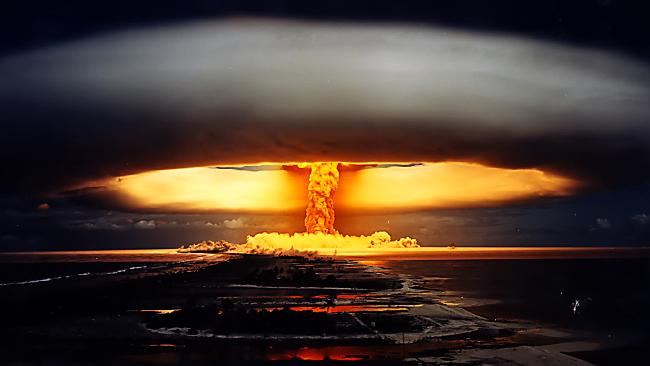Taking on Nukespeak
WEAPONS OF MASS DESTRUCTION, 8 Feb 2016
Andrew Moss, PeaceVoice – TRANSCEND Media Service
In 1946, George Orwell decried the abuse of language in his classic essay, “Politics and the English Language,” declaring famously that “it [language] becomes ugly and inaccurate because our thoughts are foolish, but the slovenliness of our language makes it easier for us to have foolish thoughts.” Orwell reserved his sharpest criticism for corrupted political language, which he called the “defense of the indefensible,” and in the years that followed, others writers took up similar critiques of political discourse, adjusting their focus according to the circumstances of the time.
One particular critique has focused on the language of nuclear weapons, and I argue that this language should be of particular concern to us today. Called “Nukespeak” by its critics, it is a highly militarized discourse that obscures the moral consequences of our policies and actions. It is a language used by military officials, political leaders, and policy experts – as well as by journalists and citizens. The language creeps into our public discussions like an invasive species, casting shadows on the way we think about our collective present and future.
For example, in a recent New York Times article, “Smaller Bombs Adding Fuel to Nuclear Fear” two Times reporters, William J. Broad and David E. Sanger, describe the ongoing debate within the Obama administration regarding the so-called modernization of our nuclear arsenal, a transformation that would result in atomic bombs with greater accuracy and a capacity for their operators to increase or decrease the explosive capability of any single bomb. Proponents argue that modernizing the weapons will reduce the likelihood of their use by increasing their deterrence to would-be aggressors while critics claim that upgrading the bombs will make their use even more tempting to military commanders. The critics also cite the costs of the modernization program – up to $1 trillion if all the related elements are taken into account.
Throughout the article, Broad and Sanger frame these issues in the language of Nukespeak. In the following sentence, for example, they include two euphemisms: “And its yield, the bomb’s explosive force, can be dialed up or down depending on the target, to minimize collateral damage.” The euphemisms, “yield” and “collateral damage,” erase the human presence – a voice, a face – from the equation of death. Though the authors do define the term “yield” as “explosive force,” the word’s presence in the text still unnerves with its contrast between benign meanings, i.e. a harvest or monetary profit, and the demonic sense of a lethal reaping. And the phrase “collateral damage” has long been recognized for its sheer mendacity, its omission of the unspeakable from any consideration.
The sentence also contains another feature of Nukespeak: an amoral fascination with deadly gadgetry. It is one thing for a person to dial down the thermostat of her home; it is another to “dial down” a payload of death. When I taught an undergraduate course on the literature of war and peace, my students and I studied in one of our units the literature of Hiroshima and Nagasaki. We read President Truman’s announcement of the dropping of the first atomic bomb, exploring how Truman discussed the genesis of the new weapon and the scientific collaboration that went into making it “the greatest achievement of organized science in history.” At the same time, we read stories by Japanese writers who managed to survive the inferno and still continue to write. One such writer, Yoko Ota, has the narrator of her short story, “Fireflies,” return to Hiroshima seven years after the bomb and encounter a number of fellow survivors, including a young girl, Mitsuko, who had been horribly disfigured by the atomic explosion. Despite the disfigurement that makes her presence in public emotionally painful, Mitsuko displays an extraordinary resilience and a “desire to grow up faster and help people who’re having a hard time.”
The psychiatrist and author Robert Jay Lifton has written that even within the nuclear shadow, we can find redemptive possibilities in the traditional “wisdom of the seer: the poet, painter, or peasant revolutionary, who, when the current world view failed, turned the kaleidoscope of his or her imagination until familiar things took on a wholly different pattern.” Lifton wrote those words in 1984, and since then the need for cooperation on a planetary scale has grown ever more urgent. Today, as before, it is the artist and seer who can recognize the human presence hidden behind the lying façade of Nukespeak. It is the artist and seer who can find the words to say: there is madness in this so-called rationality – and that, indeed, we have the capacity to find another way.
_______________________________________
Andrew Moss, syndicated by PeaceVoice, is an emeritus professor at the California State Polytechnic University, Pomona, where he taught a course, “War and Peace in Literature,” for 10 years.
This article originally appeared on Transcend Media Service (TMS) on 8 Feb 2016.
Anticopyright: Editorials and articles originated on TMS may be freely reprinted, disseminated, translated and used as background material, provided an acknowledgement and link to the source, TMS: Taking on Nukespeak, is included. Thank you.
If you enjoyed this article, please donate to TMS to join the growing list of TMS Supporters.

This work is licensed under a CC BY-NC 4.0 License.
Read more
Click here to go to the current weekly digest or pick another article:
WEAPONS OF MASS DESTRUCTION:
